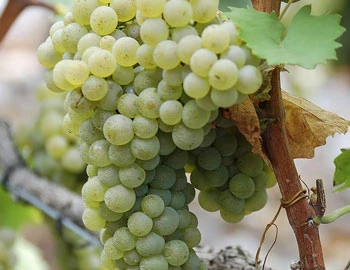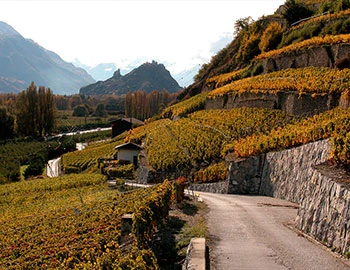Clos de Mangold Petite Arvine 2022
AOC Valais, Domaine Cornulus, 750 ml

| Grape variety: | Petite Arvine |
| Producer: | Domaine Cornulus |
| Origin: | Switzerland / Wallis |
Description
The white grape variety "Petite Arvine", typical of the Valais, thrives in the Clos de Mangold. A very typical aroma in the nose and on the palate is rhubarb. It is a great combination of fruit and vegetable, greenish aromas. On the nose, the wine exudes an aroma reminiscent of tangerine, ice candy, flint and lime. On the palate it is lively, mineral and juicy. The palate is lively, mineral and juicy, with aromas of quince, pineapple, mango and herbs. It is juicy, full-bodied and velvety soft.
Attributes
| Origin: | Switzerland / Wallis |
| Grape variety: | Petite Arvine |
| Label: | Certified organic or biodynamic wine |
| Ripening potential: | 1 to 15 years |
| Drinking temperature: | 10 to 12 °C |
| Food Pairing: | Wild fowl, Cheese board, Mild Asian dishes, Vegetable cous-cous, Salad with vegetables, pulses, pasta |
| Harvest: | hand-picking with simultaneous grape sel |
| Maturation: | in amphoras, in cement egg |
| Volume: | 14.0 % |
| Note: | Contains sulphites |
Domaine Cornulus
What started out from humble beginnings over 20 years ago is now one of Valais’ flagship wineries and the byword for both a way of working in harmony with nature and premium wines, all of which strongly bring out their individual terroir.
Valais natives and cousins Stéphane Reynard and Dany Varone are perfectionists who love what they do. They tend to their vines, which live and thrive above Sion in the village of Savièse, as if they were their own children. Thanks to Dany Varone’s meticulous and expert work in the wine cellar, they craft terroir wines of the highest quality. This winemaking duo – now part of the Valais elite – laid the foundation for their successful Domaine Cornulus project in 1986, setting up the “Buteo” wine cellar and launching their “Garage Winery”. They bought their first harvests straight off the vines of various Savièse winegrowers and started pressing them in a garage. The following year, they leased their first vines in the vineyards above Sion (less than 1 hectare). In 1989 they created the Sélection Cornulus, after which their winery is named. A few harvests later, they acquired their first plots in the Clos de Mangold in 1995. Their dream of establishing a real domaine of their own gradually took shape. “After all, you will rarely find a good wine without terroir,” say Stéphane and Dany. In 1999 there followed the “prime cut”, the famous Clos des Corbassières, the jewel in the domaine’s crown. In the course of the “noughties”, they successively acquired various Grand Cru plots between Sion and Sierre as well as Clos Chamaray, St-Charles and La Follie. The rich palette of exquisite vines was finally rounded off to perfection by the magnificent Clos des Monzuettes.

Petite Arvine
A grain of salt
The white Petite Arvine is the diva of Swiss grapes. It thrives only in the very best sites of Valais: sunny and sheltered from wind, not too dry, but not too moist. No wonder they were almost extinct. For convenience, vintners replaced the delicate plants from the beginning of the last century with more low-maintenance varieties. Their rebirth in the 1990s is thanks to dedicated companies that recognized the unique profile of this primordial Valais variety. Their hallmarks are aromas of grapefruit and rhubarb, paired with a tangy acidity and a curious, slightly salty touch at the end – like a grain of fleur de sel on the tongue. The Petite Arvine is mostly made into a dry wine, but as a sweet wine it offers a fantastic, sweet-spicy taste experience.

Switzerland
Switzerland – A small country with enormous diversity
Switzerland is famous for its banks, watches, and cheese, but not necessarily for its wine. The Swiss didn't invent wine, but they have been extremely open and curious to it. Wine culture arrived in what is now modern Switzerland via several routes: from Marseilles to Lake Geneva and the Lower Valais region; from the Aosta Valley through the Great St. Bernard Pass to the rest of Valais; from the Rhone through Burgundy, across the Jura Mountains to Lake Constance; and from Lombardy to Ticino, and then on to Grisons.



